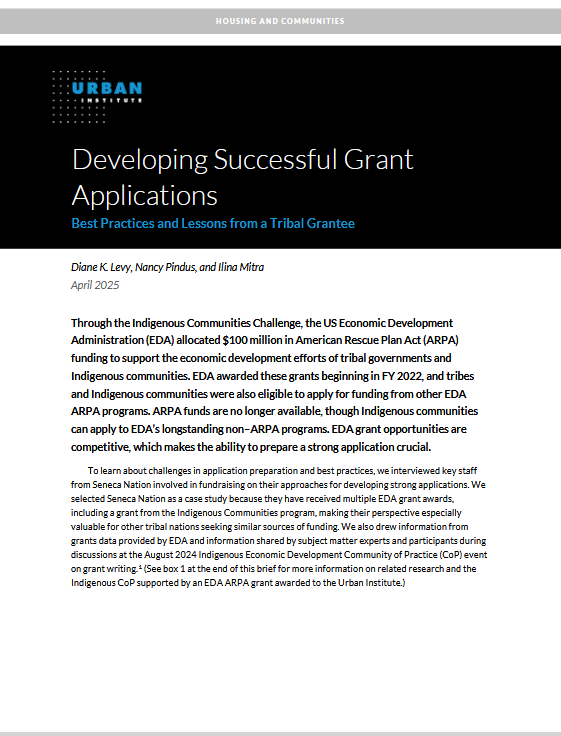Developing Successful Grant Applications: Best Practices and Lessons from a Tribal Grantee
This brief, Developing Successful Grant Applications: Best Practices and Lessons from a Tribal Grantee, is from the Urban Institute by Diane K. Levy, Nancy M. Pindus, and Ilina Mitra. It examines one tribe’s experiences applying for, and winning, grants from the US Economic Development Administration (EDA) that support economic development. It provides an overview of the application and review process, discusses application-related challenges, and draws several lessons for Indigenous applicants and for EDA.
Why This Matters
Indigenous economic development projects play important roles in supporting community strength and well-being by building health care and other community facilities, constructing housing, and developing businesses and creating jobs in alignment with an Indigenous community’s culture and values. Indigenous communities can apply to EDA for grants to support economic development projects. EDA grant opportunities are competitive, which makes the ability to prepare a strong application crucial.
Key Takeaways
Four challenges related to federal grant application processes emerged:
Meeting application requirements for proof of land ownership when tribal lands are held in trust can take considerable time and effort for grant applicants.
Meeting a construction grant’s requirements for an engineering plan and environmental review may necessitate hiring an engineering consultant if the applicant does not have an engineer on staff.
Selecting the best project to pursue requires understanding EDA’s funding categories. Input from an economic development representative can help applicants identify viable projects for a successful application.
Including data to demonstrate how the proposed project will meet an economic need can be challenging for Indigenous applicants that do not have the data or resources for local data collection that some applicants have.
Through our interviews, we identified the following lessons for Indigenous applicants:
Engage the regional economic development representative during the project conceptualization and application development stages. View this contact as a resource and guide throughout the application development and submission processes.
Develop local data, to the extent possible. Recently, EDA programs have accepted tribal applicants’ self-certification of data.
Request meetings with the economic development representative and others at EDA to discuss any application requirements that run up against land rights or other aspects of tribal sovereignty that require additional capacity.
And for EDA:
Develop relationships with individual tribal nations that have not yet engaged with EDA in addition to offering group webinars to inform prospective applicants about funding opportunities. EDA grants data indicate that in most regions, there are likely many tribal entities that have never applied to EDA for funding.
Continue efforts to work with tribes that are eligible to apply for EDA grants but for whom grant requirements pose barriers. Staff can continue efforts to review application forms and requirements to remove common barriers.
How We Did It
To learn about challenges in application preparation and best practices, we interviewed key staff from Seneca Nation involved in fundraising. We selected Seneca Nation because they have received multiple EDA grant awards, making their perspective especially valuable for other tribal nations seeking similar sources of funding. We also drew information from EDA grants data and information shared by subject matter experts and participants at an event on grant writing for Indigenous economic development practitioners.

